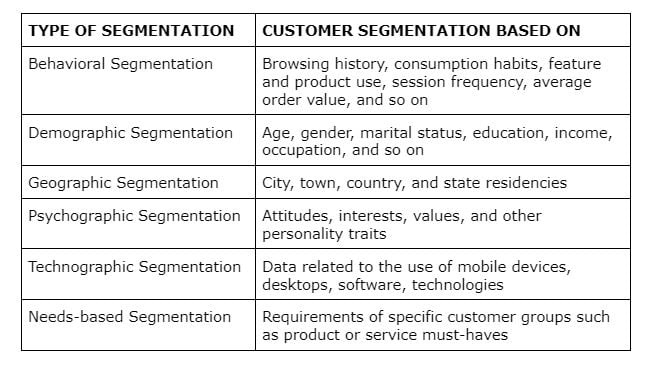Finding new ways to build and sustain customer relationships is crucial for every brand. Smart marketing leaders and CMOs resort to personalization which helps them pivot in real-time, keep costs down in uncertain economic conditions, and exhibit sensitivity to customers. Businesses can achieve precise targeting with personalized solutions, tailoring offers to customers in a relevant and contextualized manner.However, things aren’t easier in a connected consumer marketplace where you require anticipation and exceed customer expectations. Responding to changing customer expectations in a competitive market requires leveraging customer data at the most granular level.
Effective and efficient use of data analytics, AI, and automation allows you to capitalize on data for insights-driven results and modernize your marketing approach with a nuanced personalization strategy. It makes your business more customer-centric and data-driven, paving the way for enhanced digital experience solutions. This blog examines how companies can leverage these technologies to use multi-layered personalization and deliver a superior customer experience solutions.
AI, Data Analytics, and Automation: Unveiling Context-Driven Personalized Solutions
- AI and ML
AI and ML allow retailers, as well as any mass media & entertainment companies, to personalize the content recommendations they display to customers. For instance, the popular streaming service discovery+ uses Amazon Personalize to deliver personalized content experiences for individual viewers in real-time. Technologies like machine learning and NLP empower AI-enabled chatbots to understand and respond to customer queries based on the context. The ability of AI-based chatbots to provide personalized answers is highly effective for companies that cannot afford to hire a pack of customer representatives. -
Data and Analytics
Recent attention on data analytics and business intelligence has spurred a gold rush for enormous digital datasets. Data helps you understand who your customers are, how they shop, what they buy, and how they like to engage. This allows you to develop and integrate more intelligent tools to serve and retain them. When Starbucks had to rely on its mobile app and drive-through windows to serve customers during the lockdown, it started using predictive analytics to process customer data. The data comprised the location, time, and details of purchase. This helped Starbucks personally connect with customers and serve them better. Aberdeen’s research confirms that companies employing predictive analytics to foresee customer needs can increase their organic revenue by 21% year-on-year, compared to the industry average of 12% in the absence of predictive analytics. -
Automation
Big Data and machine learning algorithms help your team to create detailed profiles of individual users. They can further help in the automatic customization of offerings to those individuals For example, you can automatically push personalized content and offers to your customers using mobile, based on their location. As a matter of course, several companies tailor the content on their website to match the user’s location, language, local time zone, and currency. Automated customer support systems such as self-service portals, ticketing systems, and AI-enabled chatbots can take the brunt of providing instantaneous and personalized responses to your customers.
Connect Meaningfully in the New Reality Through Personalized Solutions
Are you challenged to deliver innovative experiences and make meaningful connections with your customers in the new normal?
To survive and thrive in the new reality, overcome the significant roadblocks comprising rapid proliferation and availability of data, evolving customer expectations, and a fluctuating market crowded with competitors.
Here are a few methods you should adopt to become successful in the new reality:
-
Customer Segmentation
93% of internet users state that the received marketing communications are irrelevant, and almost 90% are annoyed with irrelevant messaging. According to Salesforce, segmented marketing campaigns generate an increased revenue of around 760%. To effectively craft and deliver personalized content, you should apply segmentation to your marketing strategy. Segmentation refers to identifying similar groups of potential customers based on the user information gathered from multiple online sources such as website, mobile app, virtual events, ads, contact forms, emails, web chats, and so on. Here are a few examples of customer segments:
 How Segmentation Helps Your Business
How Segmentation Helps Your BusinessSegmentation allows your company to organize and manage customer relationships by making it easier to personalize your marketing, service, and sales efforts according to the needs of specific groups. It boosts your customer loyalty and conversions. Customer segmentation helps you accomplish the following benefits:
- Create targeted ad campaigns that resonate with your customer segments to boost customer loyalty and conversion rates
- Understand and prepare to face the challenges experienced by your customer segments
- Identify who your most valuable customers are and why
- Reach out to customers via their preferred channel of engagement
- Discover new opportunities for product, service, and support
- Improve your customer service and support efforts
-
Personalized Recommendations
Data shows that 92% of customers are influenced by personalized shopping cart product recommendations while making a purchase. If you display product suggestions to customers based on their preferences and online behavioral data, they are more likely to buy from you. By showing the products they have already purchased or viewed online, your conversion rate and average order value will increase, leading to lower cart abandonment and improved user experience. For example, a customer who purchased the same top in three different colors is more likely to buy the same top in a new color.
How Recommendation Engines Help Your Business
Marketers use recommendation engines to exhibit personalized product or service recommendations to customers. Recommendation engines are machine learning programs that analyze the data on both products and users to derive actionable insights. Recommendation engines explore a vast array of data such as a customer’s search queries, purchase history, items in their shopping cart, social media behavior (posts, likes, and shares), demographic details, and location to provide explicit suggestions.
Personalized product recommendations:
- Enable your customers to identify what they need to buy
- Allow you to tailor recommendations and showcase relevant products
- Encourage shoppers to make a purchase and buy again in the future
- Cross-sell and up-sell based on user preferences
-
360 Degree Customer View
Customer 360 or 360-degree customer view gives you a single unified view of the customer by aggregating relevant customer data from multiple sources into a centralized location. Tracking website visits and purchases, explicit data gathered from forms, contextual information from social channels, customer support tickets, helpdesk interactions, emails, CRM tools, etc. are a few data sources that allow you to learn about your target customers. By bringing together the data from multiple locations into one place, your organization will have access to a single version of the truth about every customer.
How 360 Customer View Helps Your Business
Robust engagement data with actionable insights into who your customers are and what they’re interested in helps you deliver hyper-personalized experiences with relevant content. Here is how a 360-degree customer view helps your business:
-
Refined customer segments: Customer 360 allows you to build processed customer segments based on customer satisfaction or purchase frequency. These segments will be more tailored to your actual customers than to your envisaged profiles.
-
Streamlines communication: A single and shared view of each customer breaks down data and operational silos and enables seamless communication between your different departments.
-
Operational efficiency: Your sales or support team can swiftly respond to inquiries and resolve issues in real-time without asking customers to repeat the information they already provided through another channel. This improves your omnichannel operational efficiency, resulting in increased customer satisfaction and reduced churn.
-
Predictive analysis: 360-degree customer view improves your ability to anticipate the customer’s needs through predictive analysis. So, you will know how to make the right offer or deliver the right content at just the right time.
-
-
CRM Integration
G2 business software review platform defines CRM integration “as the process of connecting your customer relationship management (CRM) platform with third-party business software to improve work efficiency.” Integrate your CRM suite with your sales and marketing automation solutions, e-commerce application, ERP software, customer communication management systems, and other dominant business software. CRM integration synchronizes third-party workflows and data with your CRM information.
CRM Integration Examples and Benefits
Some crucial business functions to integrate with your CRM are email, calendar, website, social media, e-commerce platform, ERP software, payments and invoices, and sales and marketing automation software. For example,
- Sync the data you receive through custom forms and surveys (using tools such as Survey Monkey or Typeform) with the lead data in your CRM. Your sales team can easily refer to and analyze the data when they prepare for sales meetings.
- Meeting software like Zoom easily integrates with your CRM and calendar app to facilitate one-click meetings from any preferred channel such as your email, calendar, CRM, or chat application.
CRM integration increases your employees’ productivity and improves your turnaround time. It provides enhanced visibility into customer interactions across multiple channels and helps you adopt a more holistic approach to business management.
-
Campaign Automation
Reading automated emails and newsletters can sometimes be an unpleasant experience. However, advanced AI tools and ML algorithms help personalize your brand engagement strategies. Email campaign automation, customer profiling, targeting, and personalization using dynamic content are a few marketing automation techniques companies use widely today. Triggered personalized campaigns generate 75% of email revenue, which is far ahead of one-size-fits-all campaigns.
How Campaign Automation Boosts Personalization
- Allows your team to create more personalized content by leveraging segmentation capabilities and reporting
- Let you target your persona on multiple channels, such as search ads, email campaigns, social media, and so on
- Simplifies the process of getting the right content to the right buyer at the right time
- Personalizes your lead nurturing process, helps with lead scoring and grading, and tracks your entire engagement with the customer
- Analyzes visitor data to trigger automatic assignment of qualified leads to the right sales representatives and further personalize the customer journey
-
Hyper-Personalization
Hyper-personalization has brought a paradigm shift in the marketing field, which was previously product-centric. It allows your organization to evolve from user-based segmentation to usage-based segmentation by leveraging Big Data. Hyper-personalization takes personalized marketing and service to a much higher level through real-time customization of offerings, content and customer experience at an individual level.
Personalized purchase recommendations, displayed by modern e-commerce platforms, based on the customer’s preferences and purchase history, and the retargeting mechanism used to display ads on the user’s screen in real-time, are some common examples of hyper-personalization.
Boost Your Customer Engagement Through Hyper-personalization
-
Hyper-contextualization is about adapting your product, service, relationship, and overall customer experience to a specific customer context.
-
Improve direct targeting at an individual level by leveraging Big Data, algorithms, and predictive models.
-
Create delightful and impactful experiences by boosting customer engagement and trust and making relevant offers.
-
Hyper-personalized marketing maximizes your revenue through dynamic pricing, reduces customer acquisition and retention costs, and helps make the most of in-moment customer journeys.
According to Deloitte, well-executed hyper-personalization can deliver 8X the ROI on your marketing spend and lift your sales by more than 10%. Doubtless, hyper-personalization pushes data collection and customer interaction beyond the point of sale(PoS) by combining data and technology.
-
Real-world Examples of Personalized Customer Experiences
-
FinTech
Digital-only or neo-banks such as Chime, Varo, Starling Bank, Atom Bank, buy-now-and-pay-later (BNPL), Banking-as-a-Service (BaaS) platforms, AI-powered prevention of cybercrime and financial fraud, etc. are some of the techniques opted by FinTech companies to personalize financial services. Subsequently, Credit Union of Texas saw a 300% rise in home equity and mortgage applications after displaying personalized CTAs to their website visitors. American Express witnessed 3X improved conversion rates and 6X lower customer acquisition costs once they started sending out personalized videos (informative, self-help hacks) to their customers along with their monthly credit card statements.
-
Retail
Virtual try-on, digital 3D product configurators, interactive product visualizations, improved in-store experiences, VR simulations, and contactless payments enable retailers to deliver hyper-personalized shopping experiences. With an AR-based virtual try-on solution for in-store and online users, a global consumer wellness brand boosted its conversion rate by 9%. The new platform makes virtual try-on a highly immersive experience for customers and offers personalized product recommendations based on a consumer’s individual attributes.
-
Healthcare
Healthcare, as such, is a highly personal thing which makes it crucial for care providers to ensure that each individual is getting the specific treatment required. Data consolidation from multiple healthcare devices, tools, wearables, paper forms, and systems, personalized diet and nutrition recommendations to maintain health and fitness, and suggesting personalized drugs for each individual are a few prominent use cases of personalization in healthcare.
The significance of data-driven personalized healthcare is gaining attention like never before. Data allows caregivers to prescribe medication and care plans based on a patient’s individual data and medical history. In one of its latest studies, the University of Colorado analyzes the application of AI and ML technologies that can go a long way in super-personalizing tumor treatment. This is made possible by examining massive public DNA databases to list common cell mutations that are treatable, which narrows down the research’s focus on rarer mutations. The in-depth classification allows clinicians to prescribe personalized drugs to their patients based on the type of mutation. Individualized medicine and healthcare advancements are expected to create significant breakthroughs on a person-to-person level.
Personalization is a dynamic business differentiator that helps match your goals with customer expectations. When reality keeps changing, pivoting in real-time becomes possible only if you make impactful connections powered by advanced technology. Srijan aims to simplify this transition for you through data modernization and build multi-layered personalization according to your specific requirements. Contact us to receive an extended consultation
Our Services
Customer Experience Management
- Content Management
- Marketing Automation
- Mobile Application Development
- Drupal Support and Maintanence
Enterprise Modernization, Platforms & Cloud
- Modernization Strategy
- API Management & Developer Portals
- Hybrid Cloud & Cloud Native Platforms
- Site Reliability Engineering




